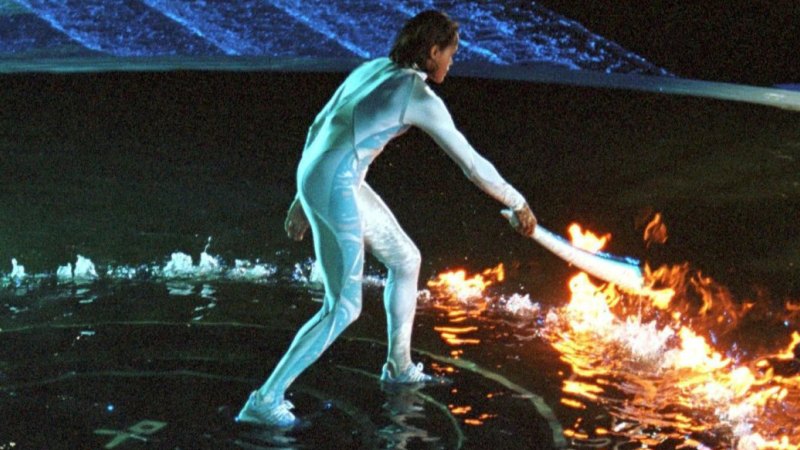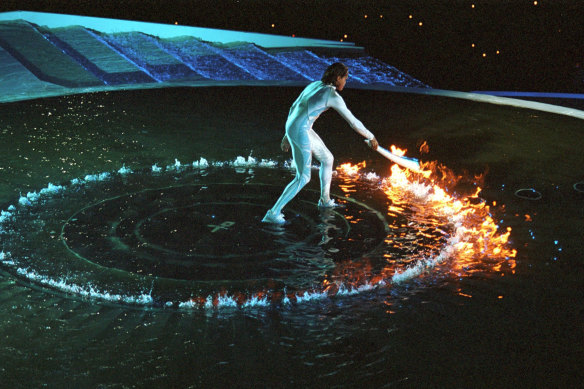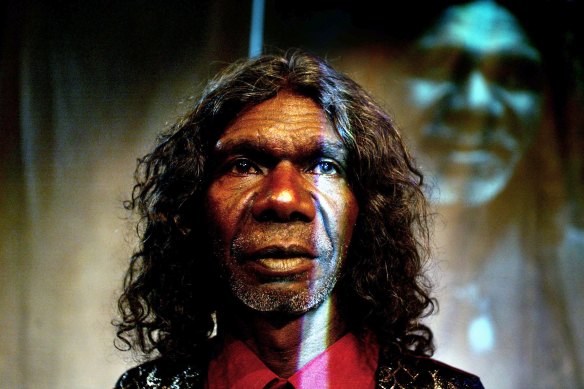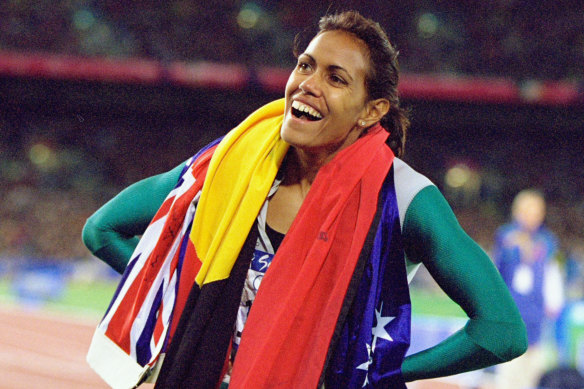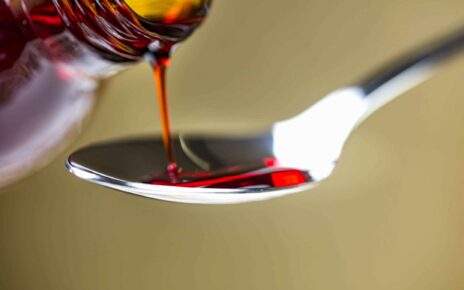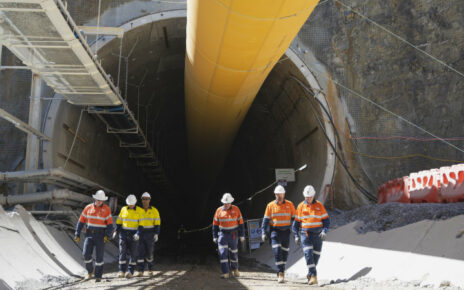Save articles for later
Add articles to your saved list and come back to them any time.
We all remember Cathy Freeman in the Millennium year. First, in the opening ceremony, standing in a pool of water like a space-age Rhinemaiden from a Barrie Kosky production of Das Rheingold, she lit the fiery caldera that rose into the sky. Then, in the 400m final, dressed in that green amphibian wetsuit, she strode to victory with her graceful, languorous strides. Sweet dancer.
After the race, Freeman said she “had been born to win Olympic gold”. Tyche, the goddess of fortune, smiled at her sense of destiny and gave victory to us all.
Cathy Freeman at the opening ceremony of the Sydney Olympic Games. Credit: Getty
But as magnificent as her achievement was, it was not as sublime as when I first heard Gurrumul Yunupingu sing, or when I first saw 16-year-old David Gulpilil dance in Nicholas Roeg’s Walkabout, or when I saw the paintings of Emily Kame Kngwarreye and Rover Thomas for the first time.
Sport can be life-enhancing, but it can never be transcendent as well – only culture and the arts can be that. As Paul Klee wrote: “The purpose of art is not to show the visible, but to make visible,” and Indigenous culture makes visible a landscape steeped in meaning and memory in ways we non-Indigenes find both strange and beautiful.
It was similar in ancient Greece. Even now, Greek roads are rarely straight – they have to be winding to avoid sacred groves and springs. I think Indigenous culture has enriched the lives of most non-Indigenous Australians and made us see this continent as if for the first time.
I think Gurrumul is Australia’s finest singer and Gulpilil our finest actor, though he was always typecast as an outback Aboriginal man and never got to play a merchant banker or a prime minister. Thomas and Kngwarreye are up there with Arthur Boyd and Sidney Nolan, and I can’t imagine life without the songs of Archie Roach and Ruby Hunter.
David Gulpilil at the launch of the 2004 season at the Belvoir St Theatre. Credit: Fairfax
When I first saw Indigenous dancers as a child, I asked my mother: “How can men become emus?” This interconnectedness with Nature was once universal but is not now the worldview of advanced societies. Is the Indigenous worldview better than ours? I don’t think those kinds of judgments can be made. I do know the Indigenous worldview cannot be mine because I am not Indigenous and was educated in the European worldview, steeped in Greek culture and Christian iconology.
This worldview began in the caves of The Swabian Jura about 40,000 BC and its totemic objects were the Hohle Fels Venus, the Stadel Cave Lion-Man, and the five-holed Hohle Fels’ flute, made from the wing bone of a griffon vulture. This was the beginning of Western culture, not as old as Australian Indigenous culture, but it did lead to Bach, Shakespeare and Goya.
Even with different traditions, there can be cross-fertilisation of cultures, and Indigenous culture is mythopoetic and from that comes The Uluru Statement and the Voice referendum. The Voice is a modest proposal, based on the 2017 Uluru Statement – there are no valid arguments against it. It is essentially a moral issue, not a political one. Lack of bipartisanship dooms it to failure. Opponents raise spurious objections that make the issue contentious – and, confused, voters opt for the status quo. Voice advocates appeal to the better angels of our nature. Opponents to the base instincts of fear, prejudice and resentment.
Dutton’s cynical opportunism gives a faux legitimacy to the extremists: the conspiracy theorists and those who prefer stagnation to change.
Moral issues are determined by informed consciences and enlightened social consensus, not by 50% +1. The terrible truth about democracy is that it guarantees nothing – not even democracy. Democracy’s fatal flaw is that a majority can elect a Trump, a Bolsonaro, a Duterte, who despise democracy.
Once there were high hopes. After the 1992 High Court Mabo judgment, Keating spent 18 months steering land rights legislation through parliament. In the Redfern Speech of 1992 he articulated the moral imperative to overturn years of injustice. But then we fell into an abyss, and it seems we are falling still. In 1997, PM John Howard called Indigenous dispossession and frontier wars a “blemish” and decried, with others, the “black armband” view of history.
Early in 1998, Howard said the controversial policies of Pauline Howard were “deranged”. But then, in June that year, Hanson won 11 seats in the Queensland state election and suddenly deranged policies became Coalition policies. To my mind, this marks the beginning of modern Western populism which tainted the Australian psyche and taints it still.
If you look hard enough, there are affinities between Indigenous and most non-Indigenous Australians. As an Irish-Australian I feel a special affinity because the trajectories of our colonial experience were much the same. In 1844, the Indigenous Irish, the “natives”, numbered almost 9 million. Their language, religion and culture were despised by the English, whose absentee landlords owned almost all the land. As tenants and subtenants, Irish families had to subsist on smaller and smaller plots of land, often less than an acre. As all cereal crops were exported to England, the native Irish had only potatoes. When the blight struck in 1845, more than a million natives starved and more than 2 million emigrated.
By that time, the entire country had been renamed. In 1833, the Royal Ordnance Survey set about naming, or “Anglicising” the whole of Ireland. Place names in Irish that had existed for centuries, even millennia, were made unrecognisable. For instance, “vinaigre” in Irish means “place of the wild berries”. In a crude transliteration the Ordnance Survey renamed it Vinegar Hill. Meaning and memory were obliterated.
In 1619, the great German astronomer Johannes Kepler wrote Harmonices Mundi, in which he envisioned Copernican cosmology as reflecting a harmonious universe. In the 1950s, Paul Hindemith wrote a superb opera based on Kepler’s book, called Die Harmonie der Welt (the harmony of the world). In 1598, Sir John Davies published his long poem Orchestra; or, A poem of dancing, which describes the entire universe as being a cosmic dance.
The Uluru Statement is an invitation to just such a cosmic dance, and all Australians are invited. Cathy Freeman, Noel Pearson, Marcia Langton, Pat Dodson, Megan Davis and others invite us to the dancing ground under the southern sky. Looking up at the night sky in Kakadu or Arnhem Land, the brightness of the stars is overwhelming – a canopy of light.
Look at the night sky. Look at the stars and remember the likes of 14-year-old Elijah Doughty, who was killed on the waste ground outside Kalgoorlie in 2016. Elijah was known as the laughing boy, “lija” to his friends. Even as you read this the desert wind is whipping away the dry earth from his burial mound. This continent is caked hard with the spilt blood of Indigenous children. But the cosmic dance can temper grief and rage.
Cathy Freeman wins gold under two flags. Credit: Nick Wilson /Allsport
So it will be with the cosmic dance Cathy Freeman has invited us to.
There is no denying a No vote will be a catastrophe for this country: the triumph of confusion and misinformation over justice. It means we are still trapped in the scoundrel years that began 25 years ago.
I urge my fellow Australians, and especially my fellow Irish-Australians to join the dance. I, for one, will be dancing with Cathy Freeman.
Michael Boylan is a freelance writer and has dedicated this article to Elijah Doughty.
Most Viewed in Politics
From our partners
Source: Read Full Article
